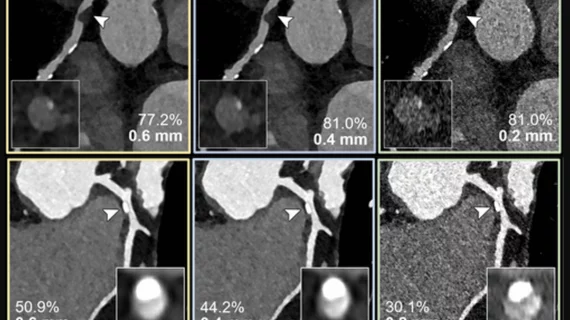Photon-counting CT improved the accuracy of coronary artery disease assessments, allowing many patients to be reclassified into a lower disease category. This further raises questions about the value of coronary CT angiography as the primary test, as it tends to be of limited diagnostic value for patients with calcium buildup in the arteries.
In a study published in the journal of Radiology, [1] researchers from Germany used an ultrahigh-spatial-resolution photon-counting detector CT, which provides better spatial resolution than a traditional CT, to compare images of patients’ arteries. After the photon-counting CT, 54% of patients in the study group had their coronary artery disease classification downgraded.
"Our study provides a glimpse into the potential impact of performing coronary CT angiography using ultrahigh spatial resolution technology on risk reclassification and recommended downstream testing," study co-author Tilman Emrich, MD, from the University Medical Center Mainz in Germany and the Medical University of South Carolina in Charleston, said in a statement.
For the study, Emrich and his colleagues examined coronary stenoses, indicating narrowing within arteries, employing a vessel phantom (in vitro) featuring two distinct stenosis grades (25% and 50%) alongside a retrospective look at 114 patients (in vivo) who underwent ultrahigh-spatial-resolution cardiac PCD-CT for coronary artery disease assessment.
In vitro findings were juxtaposed with the manufacturer's specifications for the phantom, while patient outcomes were scrutinized concerning their impact on coronary artery disease reporting and CAD-RADS (Coronary Artery Disease Reporting and Data System) reclassification.
The in vitro analysis unveiled a reduction in stenosis overestimation by ultrahigh-spatial-resolution scans, attributable to mitigated adverse effects of calcifications on image quality.
"The study used a combination of artificial vessel models and real-world patient data," Emrich said. "It simulated three types of reconstructions from a single PCD-CT scan, resembling conventional CT, high-resolution, and ultrahigh-spatial-resolution scans. Observers evaluated the severity of stenosis and generated CAD-RADS classifications, guiding further patient management decisions."
For patients with either suspected or diagnosed coronary artery disease, review of images revealed a diminished median stenosis degree for calcified plaques (29% vs. 42%) when examined with ultrahigh-spatial-resolution PCD-CT compared to standard CT scans.
Notably, the application of ultrahigh-spatial-resolution imaging often led to patients being reclassified into lower CAD-RADS categories. Among the cohort of 114 patients, 54% received a lower CAD-RADS classification than initially assigned. Additionally, the researchers noted that in vitro quantification of the 193 coronary CT angiography-based stenoses was more precise with ultrahigh-spatial-resolution compared to standard resolution techniques.
"We found that ultrahigh-spatial-resolution reconstructions resulted in significant changes in recommendations for over 50% of patients," Emrich said. "The impact was particularly notable in cases with calcified plaques, where ultrahigh-spatial-resolution reduced the overestimation of stenosis."
He added that ultrahigh-spatial-resolution has the potential to tackle the existing constraints of conventional cardiac CT angiography by eliminating the overestimation of stenosis caused by calcium blooming—an effect where small, high-density structures like calcifications appear larger than their actual size. However, the researchers found no substantial benefits from the use of ultrahigh-spatial-resolution for patients with mixed and non-calcified plaques.
The study is ultimately only a simulation and more research is necessary to quantify the benefits of photon-counting CT. Emerich notes that “further validation is needed” through more real-world imaging comparisons.
The full study is available at the link below.

